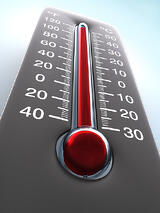Earlier this week, ASHRAE (American Society of Heating, Refrigerating and Air-Conditioning Engineers) released their latest data center cooling guidelines. As expected, ASHRAE's latest revision to their allowable and recommended cooling guidelines reflected the growing momentum in the industry for operating servers at higher levels of temperature and humidity, and of course also address the extensive money and energy savings that can be attained by raising the baseline temperature inside the data center.
While these recommendation certainly came as no surprise, what I found of particular interest was ASHRAE's assertion that there is no additional risk associated with running current servers at the upper end of the allowable operational range. Per ASHRAE's Don Beaty, “It’s good to understand what’s allowable, but the first thing to understand is that there’s no risk in going to the limit of the recommended range.” In other words, if the recommended range goes up to 80º, there is no risk in running servers right at that recommended temperature nor is there any greater margin of safety or reliability gained by running below 80º. When you consider that studies indicate that raising the temperature setpoint by just one degree could save 2–5% of
the energy consumption the value of running as close as possible to the high end of the acceptable range is obvious.
 Of course, one concern with running at the upper end of the recommended temperature range is that you must monitor the operating environment closely. After all, while running at 80 degrees may be fine, if the temperatures rises to 85 degrees you could be in trouble. To avoid this possible situation the typical data center managers might feel a need to allow some "wiggle room" just in case temperatures fluctuate a bit more than expected. So, rather placing their setpoint at 79º or 80º they instead settle for 75º or so, attaining some level of savings but also erring on the side of caution just in case things get a little warmer than expected. However, given the potential energy cost savings that those extra 4 or 5 degrees represent, this is potentially a very expensive "just in case" scenario.
Of course, one concern with running at the upper end of the recommended temperature range is that you must monitor the operating environment closely. After all, while running at 80 degrees may be fine, if the temperatures rises to 85 degrees you could be in trouble. To avoid this possible situation the typical data center managers might feel a need to allow some "wiggle room" just in case temperatures fluctuate a bit more than expected. So, rather placing their setpoint at 79º or 80º they instead settle for 75º or so, attaining some level of savings but also erring on the side of caution just in case things get a little warmer than expected. However, given the potential energy cost savings that those extra 4 or 5 degrees represent, this is potentially a very expensive "just in case" scenario.
And that's where the fine-grained, accurate, real-time environmental montoring data offered by RF Code's wire-free sensors is the key to fully optimizing your data center. By continually monitoring temperatures our solutions enable you operate as close as possible to the upper limit of the recommended range for your equipment while also ensuring that you're instantly notified if temperatures begin to drift upward. There's really no better way to balance efficiency and reliability.
Interested? Take a look at our brief video, "Data Center Energy Optimization" and learn how RF Code's small, economical, easy to deploy wire-free temperature sensors provide the critical thermal measurements you need to start the optimization process in your data center.




